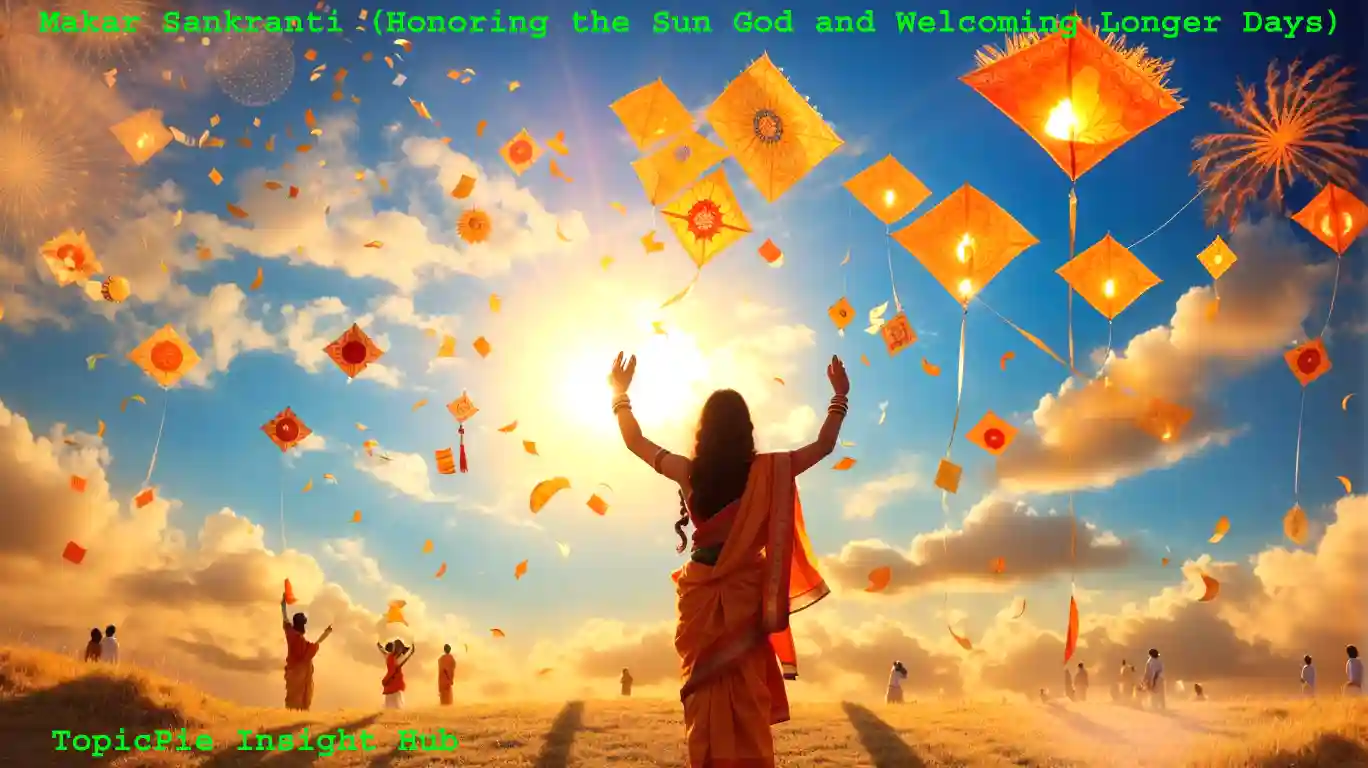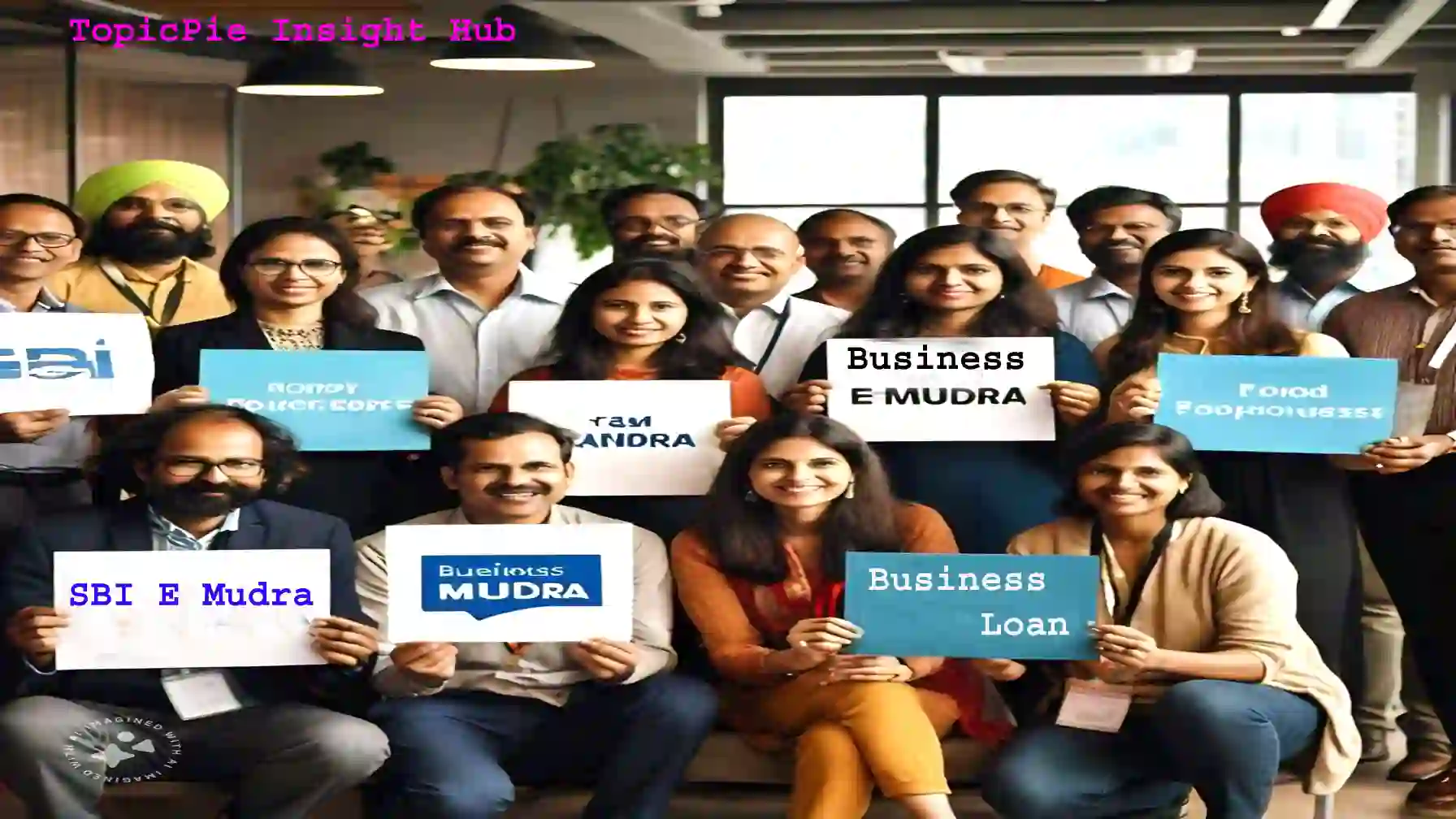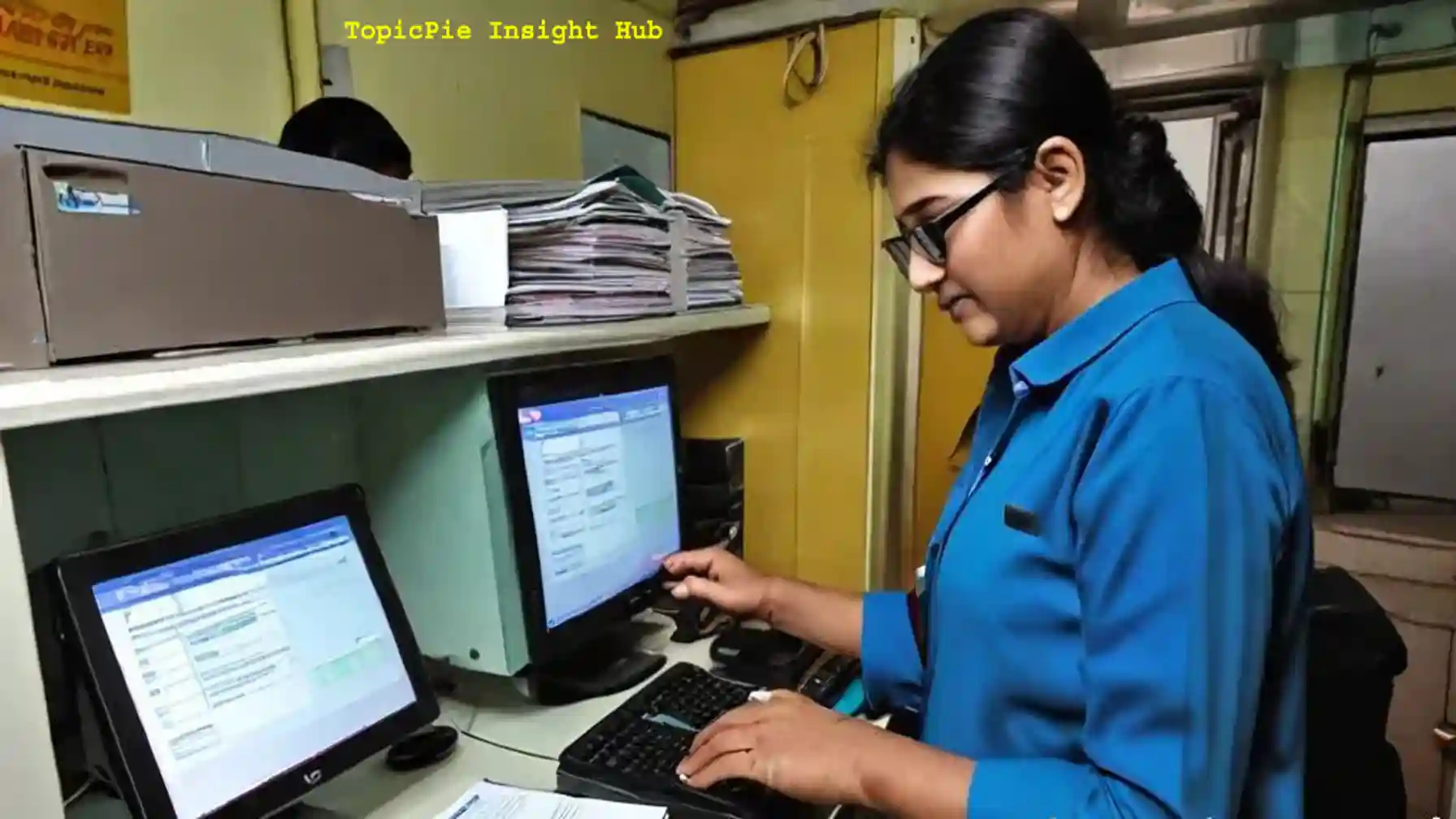Welcome to the vibrant world of Makar Sankranti, a festival that celebrates the sun’s journey into Capricorn! As winter bids adieu and longer days emerge, this occasion unites communities across India. From vibrant kites in Gujarat to til sweets in Maharashtra, each region uniquely honors the Sun God, celebrating new beginnings. Join us on a cultural journey exploring Makar Sankranti’s significance, customs, and regional variations. Don’t forget to grab your sesame ladoos for this festive extravaganza!
Honoring the Sun God and Embracing Longer Days: A Celebration of Makar Sankranti
Makar Sankranti, the festival that marks the transition of the Sun into Capricorn, holds immense significance in Indian culture. It is a celebration of longer days and warmer weather ahead. People across different regions of India celebrate the festival with great enthusiasm, rooted deep in history.
Speaking of regions, each one has its own unique customs and traditions associated with Makar Sankranti. People in Andhra Pradesh and Telangana celebrate “Pedda Panduga,” engaging in kite-flying competitions and relishing mouth-watering delicacies like pulihora (tamarind rice).
In Assam, this festival takes on a grand form called Bhogali Bihu or Magh Bihu. People build temporary huts called “Meji” where they gather around bonfires to celebrate with traditional dances and feasts.
Bihar celebrates Makar Sankranti as “Khichdi Parv”, where families come together to prepare khichdi (a dish made from rice and lentils) which symbolizes unity.
Moving towards the western region, Gujarat’s vibrant festivities include flying kites high up in the sky amidst cheers and laughter. The skies are filled with colorful kites battling for supremacy!
Haryana and Delhi witness an array of activities during this time such as organizing fairs known as “Khaps”, participating in holy dips at sacred rivers like Yamuna, exchanging sweets made from jaggery (gur), sesame seeds (til), peanuts, etc.
Jammu celebrates Lohri just a day before Makar Sankranti by lighting bonfires to mark the end of winter solstice. It is accompanied by joyful singing and dancing around these fires.
These are just snippets from various regions; there’s so much more diversity waiting to be explored! So join us on this cultural journey where we delve deeper into specific celebrations across different parts of India.
Introduction:
Welcome to the vibrant and joyous celebration of Makar Sankranti! This auspicious festival marks the transition of the sun into Capricorn, bringing longer days and brighter skies. Makar Sankranti signifies new beginnings, as it welcomes a fresh chapter in our lives.
As we gather with loved ones to celebrate this special occasion, we honor the Sun God for his warmth and nourishment. The sun holds great significance in various cultures across the world, symbolizing life, energy, and vitality. It is believed that during Makar Sankranti, offering prayers to Lord Surya brings prosperity and blessings upon us.
Makar Sankranti is not just limited to India; it is celebrated with fervor in many other countries too. Each region has its own unique customs and traditions associated with this festive day. From kite flying competitions in Gujarat to feasting on traditional delicacies like tilgul (sesame seeds) ladoos in Maharashtra, every state adds its distinct flavor to the festivities.
Also Read: Festivals in India and Beyond: Celebrations, Significance, and Unity
In Andhra Pradesh and Telangana, people participate in bull-taming events known as Jallikattu. Assam celebrates Bhogali Bihu by building makeshift huts called Meji where community feasts take place. In Bihar, devotees take a dip in holy rivers like Ganga during sunrise as part of their religious rituals.
Down South in Tamil Nadu, Pongal is a grand affair where families prepare a dish made from freshly harvested rice along with jaggery and milk as an offering to the Sun God. Kerala marks this day by conducting elephant processions known as Kumbha Bharani while Tripura celebrates Makar Mela with cultural programs.
As modern times embrace global celebrations, even countries like Sri Lanka, Malaysia, Singapore, Canada, Australia, America have started observing Makar Sankranti alongside their local festivals – showcasing unity amidst diversity.
Makar Sankranti truly embodies the spirit of togetherness and gratitude. It is a time to reflect on the past, embrace the present, and look forward to a promising future. So let us come together with open hearts and celebrate this joyous occasion as one big family!
Significance and History of Makar Sankranti:
Makar Sankranti, also known as the festival of kites, is a vibrant celebration that marks the transition of the sun into the zodiac sign of Capricorn. It holds immense significance in Hindu culture and is celebrated with great enthusiasm all over India.
This auspicious day symbolizes new beginnings and the end of winter solstice. As we bid farewell to shorter days and welcome longer ones, Makar Sankranti becomes an occasion to honor the Sun God for providing us with light, warmth, and energy.
The history of Makar Sankranti dates back thousands of years. It has ancient roots in Indian mythology and legends. According to popular belief, Lord Vishnu ended a long period of darkness by slaying a demon named Narakasura on this day. Hence, it is seen as a triumph over evil forces and a time for spiritual renewal.
Apart from its historical significance, Makar Sankranti has deep agricultural connections too. In many parts of India, it marks the beginning of the harvest season when farmers celebrate their bountiful crops with joyous festivities.
Each region in India celebrates Makar Sankranti in its unique way. From flying colorful kites in Gujarat to taking holy dips in rivers like Ganga in Uttar Pradesh – every tradition adds charm to this cultural extravaganza.
Also Read: Ram Janmabhoomi to Ram Mandir: A Journey of Faith and Belief
In Maharashtra, people exchange til gul (sesame seeds coated with jaggery) as a symbol of goodwill and unity among family members. Assam witnesses massive boat races called ‘jalsanghar’ while Punjab sees bonfires lit up on Lohri eve as part of their celebrations.
Makar Sankranti truly reflects our rich cultural diversity and brings people together through shared customs and traditions. This festival not only reminds us about our connection with nature but also reinforces bonds within families and communities.
As we delve deeper into understanding different aspects related to Makar Sankranti, we discover the beauty and significance embedded in this age-old tradition. It is a time to celebrate, to be grateful, and to spread happiness in our lives and the lives of those around us.
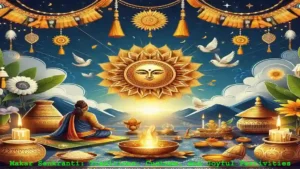
Regional Variations and Customs:
Andhra Pradesh and Telangana celebrate Makar Sankranti with great enthusiasm. The day is marked by flying kites, especially in the city of Hyderabad. People prepare traditional sweets like ariselu and garelu to share with family and friends.
In Assam, the festival is known as Magh Bihu or Bhogali Bihu. It is a time for feasting on delicacies made from freshly harvested crops. Bonfires are lit, and people participate in traditional games like buffalo fights.
Bihar witnesses the grand celebration of Makar Sankranti through kite flying competitions called ‘Patangbaazi’. The skies are dotted with vibrant kites showcasing their skills in maneuvering them.
Goa celebrates this auspicious occasion as “Uttarayan” where people exchange sugarcane sticks as a symbol of goodwill. Music, dance, and vibrant processions breathe life into the streets.
Gujarat embraces Makar Sankranti as Uttarayan – a festival that showcases its rich cultural heritage through kite festivals, especially in Ahmedabad. People enjoy flying kites all day long while relishing Gujarati delicacies like undhiyu and chikki.
Haryana and Delhi observe this festival by taking holy dips at sacred rivers like Yamuna or Ganga early morning to cleanse their souls. They also indulge in community feasts comprising traditional dishes like sarson ka saag (mustard greens) and makki ki roti (cornbread).
Jammu celebrates Lohri on the eve of Makar Sankranti by lighting bonfires to mark the end of winter solstice celebrations. People sing folk songs, perform bhangra dances around the fire while enjoying warm snacks.
Karnataka rejoices during this time under different names across regions – Pongal or Suggi Habba or Kanuma Panduga depending upon local customs. It is a time to honor the sun god, take part in bull races, and relish Pongal – a sweet dish made of rice, jaggery, and lentils.
Also Read: Christmas Day 2023: A Festive Celebration like No Other
The state of Kerala celebrates this festival as Makara Vilakku where pilgrims gather at the Sabarimala temple to witness the lighting of the Makara Jyothi (celestial light) on top of a hill. The day is also marked by feasting on traditional dishes like pongal and payasam.
In Maharashtra, Makar Sankranti is celebrated as Tilgul or Sankrant. People exchange tilgul ladoos (sweet sesame seeds balls) with the phrase “til gul ghya, god god bola” meaning “eat these sesame seeds and speak sweet words”.
In Punjab, Lohri is a major festival celebrated with bonfires, folk songs, and dances. People offer prayers to the fire god Agni for prosperity and fertility while enjoying traditional food like makki di roti (maize bread) and sarson da saag (mustard greens).
Rajasthan commemorates Makar Sankranti as Sakrat or Kite Festival where people gather on rooftops to fly kites and compete with each other. They also indulge in traditional Rajasthani delicacies like ghevar and til ke laddu.
Tamil Nadu observes this festival as Pongal, which is a four-day-long celebration. It is a time for family reunions, feasting on traditional dishes like pongal (sweet rice dish), and offering prayers to the sun god.
Uttar Pradesh celebrates Makar Sankranti as Khichdi or Tila Sakrat where people take holy dips in the Ganges river and offer prayers to the sun god. They also prepare khichdi – a savory rice and lentil dish – and distribute it as prasad (blessed food) to family, friends, and the poor.
West Bengal welcomes the harvest season with Poush Parbon or Makar Sankranti by taking dips in holy rivers like Ganga, Teesta, or Hooghly. People exchange sweets made of jaggery and sesame seeds called pithe-puli while participating in cultural programs.
Makar Sankranti in Andhra Pradesh and Telangana
Andhra Pradesh and Telangana, two states in southern India, celebrate Makar Sankranti with great enthusiasm and fervor. This festival marks the transition of the Sun into the zodiac sign of Capricorn (Makara), symbolizing new beginnings and longer days ahead.
In Andhra Pradesh, people indulge in kite flying competitions, where colorful kites fill the sky creating a vibrant spectacle. Families come together to fly kites and enjoy traditional delicacies like til ladoos made from sesame seeds and jaggery.
Telangana has its own unique customs during Makar Sankranti. One popular tradition is ‘Bommala Koluvu,’ where families set up intricate displays of dolls representing various mythological stories. People visit each other’s homes to view these displays and exchange sweets made from freshly harvested crops like sugarcane.
Both regions also organize rural sports events such as bullock cart races, cockfights, and Rangoli competitions to add excitement to the festivities. The joyous atmosphere during Makar Sankranti in Andhra Pradesh and Telangana truly reflects their rich cultural heritage.
These traditions not only honor the Sun God but also foster a sense of unity among communities as they come together to celebrate this auspicious occasion. So if you ever get a chance to be a part of Makar Sankranti celebrations in Andhra Pradesh or Telangana, don’t miss out on experiencing their unique customs firsthand!
Makar Sankranti in Assam:
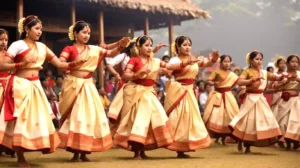
Assam, the picturesque state in Northeast India, celebrates Makar Sankranti with great enthusiasm and fervor. This festival holds a special place in the hearts of Assamese people as it marks the onset of longer days and the end of winter.
During Makar Sankranti, Assam comes alive with vibrant festivities and traditional rituals. One of the most iconic customs observed by the locals is building makeshift huts known as “Meji” using bamboo and thatch. These Mejis are then set ablaze at dawn to symbolize burning away all negative energies and welcoming new beginnings.
Another unique tradition in Assam is kite flying. The sky becomes adorned with colorful kites as families gather on rooftops or open fields to partake in friendly competitions. It’s a sight to behold as kites soar high against the clear blue backdrop.
Food plays an important role during Makar Sankranti celebrations in Assam too. People indulge in traditional delicacies like pitha (rice cakes), til pitha (sesame seed-filled pancakes), laru (sweet coconut balls), and doi-sira (curd-rice). These mouthwatering treats add flavor to the festive atmosphere.
Makar Sankranti also holds religious significance for Assamese people. Devotees visit temples early morning to offer prayers to Lord Vishnu and seek blessings for prosperity and happiness throughout the year.
Makar Sankranti brings joy, warmth, and cultural richness to every corner of Assam. The festivities capture both spirituality and community bonding, making it a cherished event for locals young and old alike.
Makar Sankranti in Bihar
Bihar, located in the eastern part of India, celebrates Makar Sankranti with great enthusiasm and fervor. The festival holds immense significance in this region, marking the transition of winter into spring.
In Bihar, people wake up early on Makar Sankranti to take a holy dip in the river Ganges. This ritual is believed to cleanse their sins and bring them good fortune for the coming year. After the bath, devotees offer prayers to Lord Sun and seek his blessings.
One of the most popular traditions observed during Makar Sankranti in Bihar is kite flying. People gather on rooftops and engage in friendly competitions as they soar their colorful kites high up into the sky. The sight of countless kites dotting the horizon creates a vibrant atmosphere filled with joy and excitement.
Another unique custom seen in Bihar is called “Tilak”. On this day, people exchange sweets made from sesame seeds (til) as a symbol of goodwill and prosperity. It is believed that consuming these sweets brings warmth to one’s body during winter days.
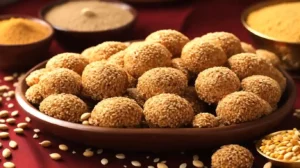
Makar Sankranti also marks an occasion for families to come together and enjoy delicious traditional delicacies such as tilkut (sweet made from sesame seeds), gur ki roti (jaggery-flavored bread), dahi-chura (curd-rice), khichdi (rice-lentil dish), etc.
Makar Sankranti holds immense cultural significance for Biharis who celebrate it with great zeal and merriment every year. It showcases their rich traditions while bringing communities closer together through various rituals and festivities associated with this auspicious day.
Makar Sankranti in Goa:
Goa, the land of sun, sand, and sea, celebrates Makar Sankranti with immense enthusiasm. This coastal state in western India has its own unique customs and traditions to mark this auspicious occasion.
One of the most popular activities during Makar Sankranti in Goa is kite flying. The sky becomes a vibrant canvas as colorful kites soar high above the beaches and fields. Families gather on rooftops or open spaces to fly kites together, creating a joyful atmosphere filled with laughter and friendly competitions.
Goa celebrates Makar Sankranti with an important tradition of preparing special sweets called til-gul laddoos, exchanging them among friends and family as a symbol of love and good wishes for the new year.
In addition to kite flying and sweet indulgence, Goans also participate in various cultural events during Makar Sankranti. Traditional dance performances such as Ghode Modni (horse dance) and Fugdi (folk dance) add charm to the festivities.
Makar Sankranti holds great significance for Goans as it marks the transition from winter to spring. It signifies new beginnings, harvest season, and longer days filled with abundant sunshine. The festival brings people closer together, fostering unity and happiness among communities across Goa.
As Makar Sankranti approaches each year, Goa comes alive with vibrant celebrations that showcase its rich culture and heritage. It’s an experience not to be missed if you find yourself in this beautiful coastal region during this festive time!
Makar Sankranti in Gujarat
Gujarat is a state in western India that celebrates Makar Sankranti with great enthusiasm and fervor. The vibrant land of Gujarat has its own unique way of honoring the Sun God and welcoming longer days.
In Gujarat, Makar Sankranti is known as Uttarayan, and it holds immense cultural significance. People gather on rooftops to fly colorful kites, filling the sky with a beautiful display of colors. It is believed that flying kites during Uttarayan brings good luck and prosperity for the year ahead.
Apart from kite-flying, there are various other traditions associated with Makar Sankranti in Gujarat. Women dress up in traditional attire and perform folk dances like Garba and Dandiya-Raas. To celebrate this auspicious occasion, people prepare special delicacies like til laddoos (sesame seed sweets) and undhiyu (mixed vegetable curry).
The festival also showcases the rich heritage of Gujarat through various cultural events and competitions held across the state. From kite-making workshops to food festivals featuring traditional Gujarati dishes, there is something for everyone to enjoy during this festive season.
Uttarayan in Gujarat is a time when people come together to celebrate joyfully, embracing the warmth of the sun’s rays after long winter months. It truly embodies the spirit of Makar Sankranti – honoring nature’s cycle while rejoicing in unity and happiness!
Makar Sankranti in Haryana and Delhi
Haryana and Delhi celebrate Makar Sankranti with great enthusiasm, marking the transition of the sun into Capricorn. The festival holds immense significance in these regions, symbolizing new beginnings and longer days ahead.
In Haryana, people gather on rooftops to fly kites and engage in friendly competitions. The sky is adorned with vibrant colors as families come together to showcase their kite-flying skills. Children run around excitedly, trying to catch fallen kites and shouting with joy when they succeed.
Delhi also showcases its love for kite flying during Makar Sankranti. Rooftops become lively hubs of activity as people participate in kite battles, attempting to cut each other’s strings. The atmosphere is filled with laughter and cheers as friends and family members cheer on their loved ones from below.
Apart from kite flying, Haryanvi and Delhite communities indulge in feasting during this festive time. People prepare traditional delicacies like sweet sesame seed balls (til ke laddoo), gajak (sweets made from jaggery and sesame seeds), mustard greens curry (sarson ka saag), and more. They lovingly share these dishes with neighbors.
Makar Sankranti brings a sense of unity between the people of Haryana and Delhi as they come together to honor the sun god while enjoying fun-filled activities like kite flying and relishing traditional food items specific to this auspicious occasion.
Jammu
Jammu, the winter capital of Jammu and Kashmir, celebrates Makar Sankranti with great enthusiasm. The city is known for its rich cultural heritage and diverse traditions. During this festival, people gather at various temples to offer prayers and seek blessings from the Sun God.
In Jammu, Makar Sankranti holds special significance as it marks the end of harsh winters and welcomes longer days filled with warmth and sunshine. The locals engage in joyful activities like kite flying, bonfires, singing folk songs, and dancing to traditional tunes.
The festivities are incomplete without indulging in mouth-watering delicacies like til ladoos (sesame seed sweets), patisa (flaky sweet dish), gajak (crunchy sesame brittle) along with steaming cups of tea or coffee.
As the sun shines brightly over the snow-capped mountains surrounding Jammu during this festive season, it creates a picturesque backdrop for all the celebrations. People from different communities come together to share their joy and happiness during Makar Sankranti.
Jammu truly embraces the spirit of Makar Sankranti by honoring the Sun God while cherishing their unique customs and traditions. It’s a time when families unite, friends mingle, and laughter fills every corner of this vibrant city. So if you ever get a chance to visit Jammu during Makar Sankranti, don’t miss out on experiencing its colorful festivities firsthand!
Karnataka
The southern state of Karnataka celebrates Makar Sankranti with great enthusiasm, just like the rest of India. It is known as “Sankranthi” in Kannada, the local language. People here engage in a variety of customs and traditions to mark this auspicious day.
One popular tradition is the exchange of sugarcane and sesame sweets called “Yellu Bella”. The sweet mixture symbolizes good luck and prosperity for the year ahead. Families also gather on their rooftops to fly colorful kites, creating a vibrant spectacle across the sky.
In rural areas, farmers celebrate by offering prayers to their cattle for their hard work throughout the year. They decorate their cows with flowers and turmeric paste before conducting special rituals.
Karnataka’s rich cultural heritage comes alive during Makar Sankranti as people participate in traditional dances like Kamsale and Dollu Kunitha. These folk performances showcase the talent and creativity of local artists.
Moreover, devotees also take holy dips in rivers such as Tungabhadra or Krishna while chanting hymns dedicated to Lord Vishnu.
Makar Sankranti truly showcases Karnataka’s deep-rooted traditions and fervor towards celebrating this joyous festival.
Maharashtra
Maharashtra, the land of diverse cultures and traditions, celebrates Makar Sankranti with great enthusiasm. This festival holds a special place in the hearts of Maharashtrians as it marks the transition of winter into spring. The vibrant festivities and customs associated with this festival make it a joyous occasion for everyone.
In Maharashtra, Makar Sankranti is celebrated with kite flying competitions that fill the sky with colorful kites. People come together on their rooftops or open grounds to fly kites and participate in friendly battles to bring down each other’s kites. The atmosphere resonates with laughter, cheers, and shouts of “Kai Po Che!” as kites soar high above.
In Maharashtra during Makar Sankranti, a unique tradition involves exchanging sweets made from sesame seeds (tilgul) and jaggery (gul). This tradition, known as “Tilgul Ghya Ani God God Bola,” includes offering these sweet treats to friends and family. People exchange warm wishes for good health and prosperity during this festive ritual.
Additionally, Maharashtrian women adorn themselves in traditional attire like nauvari sarees – nine-yard saris draped in a distinct style – and perform folk dances like Lavani during community gatherings known as Haldi-Kunku. These celebrations foster unity among communities while showcasing the rich cultural heritage of Maharashtra.
The significance of Makar Sankranti lies not only in its festive fervor but also in its deeper spiritual meaning. It signifies moving towards lightness from darkness, symbolizing inner transformation by shedding negativity and embracing positivity.
Makar Sankranti brings joy, warmth, and unity to all Maharashtrians who eagerly await this auspicious day every year. With its unique customs, delicious delicacies, and spirited kite flying battles filling the air with excitement; Maharashtra truly embraces the essence of this celebration wholeheartedly.
Odisha
In the beautiful state of Odisha, Makar Sankranti is celebrated with great enthusiasm and fervor. The festival holds immense significance for the people here as it marks the transition of the sun into Capricorn, signifying the end of winter and the beginning of longer days.
One unique custom observed in Odisha during Makar Sankranti is ‘Makara Chaula’. On this day, people prepare a special dish called ‘Makara Chaula’ which consists of newly harvested rice, jaggery, coconut, banana, sesame seeds, and various other ingredients. This delicious offering is then distributed among family members and neighbors as a symbol of goodwill and harmony.
Another interesting tradition followed in Odisha is kite flying. People gather on rooftops or open fields to fly colorful kites high up in the sky. It creates a vibrant atmosphere filled with laughter and excitement as everyone tries to outdo each other in maneuvering their kites.
Various cultural programs across different parts of Odisha organize the festival. Local artists perform traditional dance forms like Ghumura and Gotipua, beautifully depicting Hindu mythology stories through graceful movements.
Makar Sankranti holds a special place in the hearts of Odias as they come together to celebrate this joyous occasion with rituals, feasts, music, dance, and lots of happiness.
Punjab
Punjab, the land of rivers and fertile plains, celebrates Makar Sankranti with great enthusiasm and fervor. This vibrant state in northern India has its own unique customs and traditions associated with this auspicious festival.
One of the highlights of Makar Sankranti in Punjab is the kite-flying competition that takes place across cities and villages. Colorful kites fill the sky as people showcase their skills in maneuvering these flying wonders. It’s a sight to behold!
Another important aspect of celebrating Makar Sankranti in Punjab is preparing traditional dishes like sarson ka saag (mustard greens) and makki di roti (cornbread). These hearty delicacies are enjoyed by families and friends who come together to share a warm meal on this special day.
In addition to kite-flying and feasting, Punjabis also partake in bonfires called “Lohri” as part of their Makar Sankranti celebrations. Dancing around the bonfire, singing folk songs, and offering prayers for prosperity are customary during this joyous occasion.
Makar Sankranti holds immense significance for farmers in Punjab as it marks the end of winter and the onset of longer days. It symbolizes hope for a bountiful harvest season ahead.
Punjab truly embraces the spirit of Makar Sankranti through its vibrant festivities that blend tradition with modernity. The warmth, energy, and exuberance displayed by Punjabis during this time make it an unforgettable experience for all who participate.
If Makar Sankranti finds you in Punjab, prepare to immerse yourself in a vibrant celebration with music, dance, delicious food, and a strong sense of community spirit!
Rajasthan and Western Madhya Pradesh (Malwa and Nimar)
Rajasthan and Western Madhya Pradesh, particularly the regions of Malwa and Nimar, celebrate Makar Sankranti with great enthusiasm. The festival holds immense significance in these parts of India, where it is known as ‘Sakrat’ or ‘Kite Festival’.
During this time, the skies are adorned with vibrant kites of various shapes and sizes. People gather on rooftops to fly their colorful creations while engaging in friendly kite-flying competitions. The air is filled with excitement as participants try to cut each other’s strings and claim victory.
Apart from kite flying, another unique custom observed in these regions is the exchange of til-gud (sesame seeds and jaggery) along with greetings. This sweet delicacy symbolizes the importance of harmony and unity among people.
In Rajasthan, Makar Sankranti also marks the beginning of a series of fairs called “Melas” that continue throughout the year. These fairs attract tourists from all over who come to witness traditional folk dances, music performances, camel races, puppet shows, and indulge in local delicacies.
The celebrations in Malwa region take on a spiritual tone as devotees visit temples dedicated to Lord Shiva or Goddess Durga. They offer prayers for prosperity and seek blessings for a bountiful harvest season ahead.
The festivities surrounding Makar Sankranti in Rajasthan and Western Madhya Pradesh bring communities together through shared traditions such as kite flying, cultural performances, temple visits, and indulging in traditional sweets.
Tamil Nadu, Puducherry, and Sri Lanka
In the southern part of India lies the vibrant state of Tamil Nadu, where Makar Sankranti is celebrated with great enthusiasm. People here gather on rooftops and fly colorful kites in the clear blue sky. The sight of these soaring kites fills the air with joy and excitement.
Puducherry, a charming coastal town known for its French influence, also celebrates Makar Sankranti in its own unique way. Locals come together at beaches to indulge in kite flying competitions and other traditional festivities. The serene backdrop of palm-fringed shores adds an extra touch of beauty to this celebration.
Across the waters in neighboring Sri Lanka, Makar Sankranti is observed by both Hindus and Buddhists. In rural parts of Sri Lanka, farmers express their gratitude towards nature’s bounty by offering prayers and making offerings at temples. It’s a time for reflection and giving thanks for a successful harvest season.
Each region has its own customs and traditions that make Makar Sankranti truly special. From flying kites to feasting on delicious sweets made from jaggery, sesame seeds, and coconut – this festival brings people together to celebrate the warmth of longer days ahead.
So if you find yourself in Tamil Nadu or Puducherry during Makar Sankranti or happen to be visiting the beautiful island nation of Sri Lanka around this time, don’t miss out on experiencing these unique cultural celebrations firsthand!
Kerala
Kerala, the beautiful southern state of India, celebrates Makar Sankranti with great fervor and enthusiasm. Known as “Pongal” in Kerala, this festival holds a special place in the hearts of its people. The festivities start early in the morning as families gather to prepare a traditional dish called “Pongal” using freshly harvested rice.
Homes are adorned with colorful Kolams (floor decorations) made of rice flour and vibrant flowers. People wear their finest clothes and visit temples to offer prayers and seek blessings from the deities. On this auspicious day, devotees also take holy dips in rivers and lakes.
One unique tradition observed during Pongal is the ritual of making bonfires. These fires symbolize new beginnings and prosperity. Families come together around these bonfires, singing folk songs and dancing to celebrate the harvest season.
The celebrations continue for four days, each day signifying different aspects such as worshiping cattle or paying homage to ancestors. Makar Sankranti brings immense joy and unity among the people of Kerala as they welcome longer days filled with abundant sunshine.
So if you happen to be in Kerala during Makar Sankranti/Pongal time, don’t miss out on experiencing this vibrant celebration that showcases the rich cultural heritage of God’s Own Country!
Tripura
Tripura, a beautiful state nestled in the northeastern part of India, celebrates Makar Sankranti with great enthusiasm and zest. The festival holds immense significance for the people of Tripura as it marks the transition of winter into spring and brings hope for a bountiful harvest.
During Makar Sankranti, the locals engage in various traditional activities that reflect their rich cultural heritage. One such activity is kite flying, where colorful kites fill the sky and create a vibrant spectacle. Families come together to fly kites and compete with each other, adding to the festive spirit.
Another unique tradition observed in Tripura during this time is ‘Hojagiri’, a graceful dance form performed by women balancing earthen pots on their heads while gracefully moving to rhythmic beats. It is believed that performing Hojagiri brings good fortune and prosperity.
The cuisine of Tripura also plays a vital role during Makar Sankranti festivities. People indulge in delicious dishes like Chakhwi (pork cooked with bamboo shoots), Muya Awandru (smoked dry fish) and Bangui Pitha (rice cake stuffed with coconut).
Makar Sankranti in Tripura showcases not only religious fervor but also promotes unity within communities. The celebration transcends boundaries as people from different ethnic backgrounds join hands to celebrate this auspicious occasion together.
Immerse yourself in the vibrant festivities of Makar Sankranti in Tripura and let its charm and warmth captivate you. The joyous atmosphere filled with laughter, music, dances, and mouth-watering delicacies truly makes this festival an unforgettable experience for everyone involved.
Uttar Pradesh
Uttar Pradesh, the land of cultural diversity and rich heritage, celebrates Makar Sankranti with great fervor and enthusiasm. This auspicious festival holds a special place in the hearts of people across the state. The festivities begin with devotees taking a holy dip in rivers like Ganga, Yamuna, and Saraswati.
In Uttar Pradesh, kite flying is an integral part of Makar Sankranti celebrations. The sky becomes a vibrant canvas as colorful kites soar high above. People engage in friendly competitions to see who can keep their kite flying for the longest time or cut down opponents’ kites.
Another popular tradition is preparing til laddoos (sweet sesame seed balls) and gud ke chawal (rice cooked with jaggery). These traditional delicacies are shared among family members and friends as a symbol of good luck and prosperity.
The rural areas come alive during this festive season with various fairs organized where local artisans showcase their handicrafts and artworks. Cultural programs showcasing folk dances like Charkula dance, Raslila, Nautanki, etc., add joy to the festivities.
Makar Sankranti unites people from different communities as they come together to celebrate this harvest festival. It is indeed a sight to behold when people gather on rooftops or open fields to fly kites while exchanging warm wishes and spreading happiness all around.
Uttar Pradesh truly embraces the spirit of Makar Sankranti by fostering unity amidst diversity through its unique customs and traditions associated with this joyful occasion.
Uttarakhand
Uttarakhand, nestled in the lap of the majestic Himalayas, celebrates Makar Sankranti with great enthusiasm and fervor. This festival holds a special place in the hearts of the people here. The picturesque landscapes of Uttarakhand come alive during this time as locals participate in various cultural activities and customs.
One unique custom observed in Uttarakhand is known as “Khichdi.” On this day, families gather together to prepare a traditional dish made from rice and lentils cooked together. This Khichdi is then offered to the deities and distributed among family members as prasad. It symbolizes unity, abundance, and prosperity.
Another popular tradition followed in Uttarakhand during Makar Sankranti is kite flying. People take to open fields or rooftops to fly colorful kites against the backdrop of snow-capped mountains. The sky gets adorned with vibrant kites soaring high amidst shouts of joy and laughter.
The celebration also includes bonfires called “Kumauni Holi,” where people sing folk songs, dance, and indulge in local delicacies like gulgule (sweet fritters) and til ke laddoo (sesame seed sweets).
As dusk falls on this auspicious day, devotees visit temples dedicated to Lord Shiva or Goddess Ganga along pristine riverbanks. They offer prayers for blessings and purification while immersing themselves in the serene ambiance.
Uttarakhand truly showcases its rich cultural heritage during Makar Sankranti festivities. The warmth of community gatherings combined with breathtaking natural beauty creates an unforgettable experience for both locals and visitors alike.
West Bengal
In the vibrant state of West Bengal, Makar Sankranti is celebrated with great fervor and enthusiasm. The festival holds a special significance for the people here as it not only marks the end of winter but also signifies the beginning of a new harvest season.
One of the most popular customs observed during this time is flying colorful kites in the clear blue skies. The sight of numerous kites soaring high, competing with each other, fills the atmosphere with excitement and joy. Families and friends gather on rooftops, bonding over friendly kite-flying competitions.
Another unique tradition followed in West Bengal is making intricate designs called ‘Alpana’ using rice flour paste or colored powders at doorsteps and courtyards. These beautiful patterns symbolize prosperity and are believed to invite blessings into homes.
No celebration in West Bengal is complete without delicious food! People indulge in mouthwatering delicacies like ‘Pithe’ (sweet rice cakes), ‘Payesh’ (rice pudding), and ‘Patishapta’ (stuffed sweet pancakes). These traditional sweets add a touch of sweetness to everyone’s celebrations.
Cultural programs, including dance performances, music concerts, and theatrical shows, enliven the state with the festive spirit. It’s a time when people come together to showcase their rich cultural heritage through various art forms.
Makar Sankranti in West Bengal truly embodies unity, happiness, and gratitude towards nature’s bounty. It brings communities closer as they celebrate together while honoring their traditions passed down through generations.
Bangladesh
Bangladesh is a region that celebrates Makar Sankranti with great enthusiasm and fervor. The festival holds immense cultural significance in this part of the world, bringing people together to honor the Sun God and welcome longer days.
Bangladesh celebrates Makar Sankranti, known as Poush Sangkranti or Shakrain, with colorful kite flying competitions filling the vibrant sky. The skies dazzle with kites of various shapes and sizes, mesmerizing everyone involved.
Another unique aspect of Shakrain in Bangladesh is the tradition of arranging boat races on rivers and water bodies. People gather around these water bodies to witness thrilling races between beautifully decorated boats, showcasing their skills and teamwork.
Apart from kite flying and boat races, people also indulge in traditional games like bull racing during this time. These activities create a sense of excitement and joy among both young and old alike.
The food plays an integral role in celebrating Makar Sankranti in Bangladesh as well. Families prepare traditional sweets like pitha (rice cakes), payesh (rice pudding), patishapta (sweet stuffed pancakes), and share them with friends, family, and neighbors.
Makar Sankranti celebrations in Bangladesh are a blend of vibrant traditions that bring communities closer while honoring their cultural heritage.
Nepal
Tucked away in the Himalayas, Nepal celebrates Makar Sankranti with great enthusiasm and fervor. The festival holds a special place in the hearts of Nepalese people as it marks the onset of longer and warmer days after months of cold weather.
Nepali communities celebrate Makar Sankranti as Maghe Sankranti or Maghi on the first day of the month of Magh, typically around mid-January. On this day, families gather together to honor their ancestors and pay homage to Lord Vishnu.
One prominent tradition during Maghe Sankranti is taking holy dips in sacred rivers such as Bagmati and Narayani. Devotees believe that bathing in these rivers purifies them from sins and brings good luck for the year ahead.
Another significant aspect of this festival is flying kites. Children and adults alike take to rooftops and open fields to fly colorful kites, symbolizing freedom and joy. The sky comes alive with a myriad of vibrant colors as people compete to see whose kite can soar highest.
Food also plays an important role during Maghe Sankranti celebrations in Nepal. Families prepare traditional delicacies like ghee-drenched rice pudding called “khir,” sesame seed laddoos known as “til ko laddoo,” and various other sweets made from molasses or jaggery.
Bonfires light up towns and villages, continuing the festive spirit well into the evening. People gather around these fires, singing folk songs, dancing, playing musical instruments, and enjoying each other’s company.
Makar Sankranti truly showcases Nepal’s rich cultural heritage and strong sense of community bonding. It is a time when people come together to celebrate new beginnings while cherishing their traditions passed down through generations.
Pakistan (Sindh)
Makar Sankranti, known as “Maghi” in the province of Sindh, holds a special place in the hearts of Sindhis. People across the region celebrate this vibrant festival with great enthusiasm and joy.
Sindhis mark this auspicious day by flying colorful kites high up in the sky. The skies come alive with a riot of colors as people engage in friendly kite-flying competitions. People believe that flying kites on Makar Sankranti brings good luck and prosperity for the year ahead.
The festivities also include exchanging sweets and traditional dishes with friends, family, and neighbors. People dress up in their finest attire and visit temples to offer prayers to Lord Sun (Sun God). Devotees make generous donations to temples and charities as an act of gratitude for blessings received throughout the year.
During Makar Sankranti celebrations in Sindh, people from different communities actively come together to participate in various cultural events organized across cities and towns, fostering unity and harmony.
The rich cultural heritage of Pakistan’s Sindh province reflects in Makar Sankranti, where generations pass down traditions, ensuring ongoing joy.
Sri Lanka, Malaysia, Singapore, Canada, Australia, America, and some European countries:
Sri Lanka, Malaysia, Singapore, Canada, Australia, America, and some European countries also celebrate Makar Sankranti with great enthusiasm. While the traditions may vary slightly in each region, the underlying theme of honoring the Sun God remains the same.
Tamil communities in Sri Lanka celebrate Makar Sankranti, known as Thai Pongal. They cook a special dish called Pongal using freshly harvested rice and offer it to the Sun God as a symbol of gratitude for a bountiful harvest.
Malaysia and Singapore also embrace this festival with cultural events and festivities. The Indian diaspora in these countries gather to fly colorful kites in open fields or on rooftops to signify their connection with nature. It’s a stunning sight to witness hundreds of kites soaring high against clear blue skies.
Similarly, Indian communities residing in Canada, Australia, America, and various European countries come together to mark this auspicious occasion. These celebrations often include traditional dances like Garba or Bhangra performances accompanied by lively music that fills the air with joyous energy.
Makar Sankranti has transcended geographical boundaries and become an opportunity for people from different cultures to connect through shared traditions. It serves as a reminder that regardless of where we are located on this vast planet Earth, our reverence for nature binds us all together.
So whether you find yourself celebrating Makar Sankranti amidst palm-fringed beaches in Sri Lanka or snowy landscapes in Canada – take part in the festivities wholeheartedly! Embrace diversity while cherishing unity; after all, festivals have an incredible way of bringing people closer no matter where they are in the world!
Makar Sankranti in Modern Times:
Makar Sankranti has evolved with the changing times, but its essence remains intact. In modern times, this festival holds a special place in the hearts of people across India and beyond. Communities come together to embrace their cultural heritage, celebrating Makar Sankranti with great enthusiasm and joy.
One notable change in recent years is the increased use of technology to spread festive cheer. Social media platforms buzz with greetings and photos showcasing colorful kites soaring high in the sky. People share their traditional recipes, rituals, and experiences online, connecting with others who celebrate Makar Sankranti.
Another significant development is the commercialization of this festival. Decorative items such as kites, colorful clothes, jaggery sweets (a Makar Sankranti staple), and kite-flying accessories flood the markets.
However, amidst these changes, it’s heartening to see that many people still uphold the traditional customs associated with Makar Sankranti. Families continue to gather on rooftops or open fields to fly kites as a symbol of letting go of past troubles and embracing new beginnings.
Moreover, many organizations organize kite-flying competitions and cultural events during Makar Sankranti celebrations. These events serve as a platform for artists to showcase their talent through dance performances or music concerts while keeping alive the spirit of this auspicious day.
Even though some aspects have changed over time due to globalization and urbanization influences on culture ,Makar Sankranti continues to be an important festival that brings communities together while honoring nature’s cycles.
Conclusion:
Makar Sankranti is a vibrant and joyous festival that holds great significance in various parts of India, as well as in neighboring countries. It is a time when people come together to honor the Sun God and celebrate the transition of winter into longer days. A plethora of customs, regional variations, and traditions mark the festival, contributing to its rich cultural tapestry.
From Maharashtra’s kite-flying extravaganza to Punjab’s bonfires and Tamil Nadu’s elaborate feasts, each state has its own unique way of celebrating Makar Sankranti. These diverse celebrations reflect the unity amidst diversity that defines India.
In modern times, Makar Sankranti continues to hold immense importance not only for religious reasons but also for social bonding. As families gather to fly kites, exchange sweets and greetings, it strengthens relationships and fosters community spirit.
As we bid farewell to winter and welcome the longer days ahead, Makar Sankranti serves as a reminder of hope, renewal, and new beginnings. It reminds us all to embrace change with open hearts and celebrate life’s cycles.
So this year on Makar Sankranti, let us join hands with our loved ones and rejoice in the warmth of the sun’s rays. Let us cherish our traditions while embracing new customs that bring us closer together. May this festive season fill our lives with happiness, prosperity and love!
Wishing you all a very Happy Makar Sankranti!
